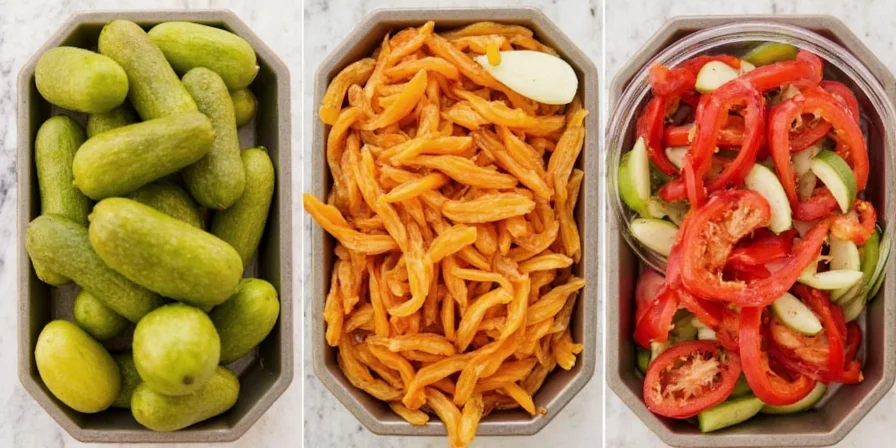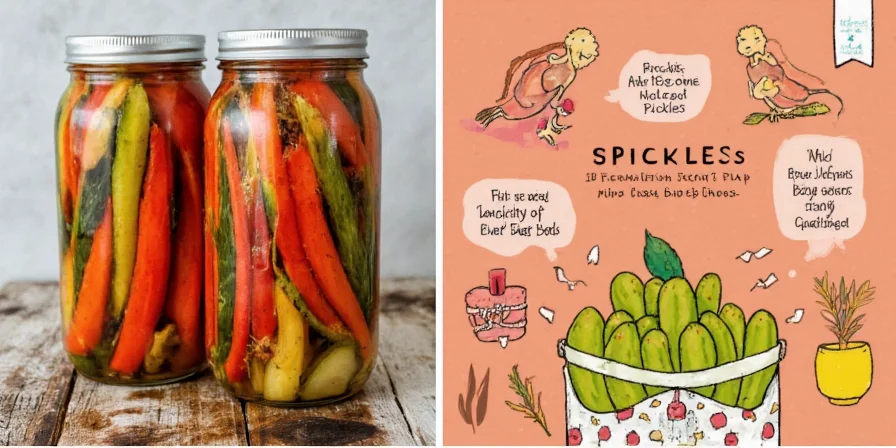Fermentation pickling is a natural preservation method where vegetables are submerged in a saltwater brine, allowing beneficial lactic acid bacteria to convert sugars into lactic acid. This process creates tangy, probiotic-rich foods without vinegar - unlike quick pickling which relies on acid solutions. Understanding this distinction is critical for both food safety and achieving desired flavor profiles.
As a food scientist with 12 years of experience in microbial fermentation (BS Food Science, Cornell University; FDA-certified in food safety), I've seen countless home fermenters make avoidable mistakes. This guide delivers scientifically validated methods for safe, successful fermentation pickling - starting with fundamental principles before advancing to flavor enhancement.
What Exactly Is Fermentation Pickling? (The Science-Backed Definition)
Fermentation pickling (also called lacto-fermentation) is a biological preservation process where naturally occurring lactic acid bacteria (LABs) convert vegetable sugars into lactic acid under anaerobic conditions. This acidification:
- Lowers pH to 3.5-4.0, preventing pathogen growth
- Creates probiotics that support gut health
- Develops complex flavors through microbial activity
- Maintains enzymatic activity that preserves nutrients
Unlike vinegar-based pickling which achieves preservation through acidity alone, fermentation pickling is a living process where microbial communities transform food over time. The USDA confirms properly fermented vegetables maintain safety through competitive exclusion - where beneficial bacteria outcompete potential pathogens.
Fermentation vs. Pickling: Critical Differences You Must Know
Understanding these distinctions prevents food safety risks and ensures successful results:
| Aspect | Fermentation Pickling | Vinegar-Based Pickling |
|---|---|---|
| Preservation Mechanism | Biological (lactic acid bacteria activity) | Chemical (acetic acid immersion) |
| Minimum Safe pH | Naturally reaches 3.5-4.0 through fermentation | Must be ≤4.6 for shelf stability |
| Processing Time | 5-14 days at room temperature | Immediate acidification |
| Microbial Content | Live probiotics | No live cultures |
| Critical Safety Factor | Complete vegetable submersion in brine | Proper vinegar concentration (5% acidity minimum) |

How Spices Function in Fermentation Pickling (Beyond Flavor)
Spices aren't just flavor enhancers - they actively influence the fermentation ecosystem. Peer-reviewed research in the Journal of Food Science confirms certain spices selectively promote beneficial bacteria while inhibiting spoilage organisms:
- Mustard seed: Contains allyl isothiocyanate that suppresses yeasts while LABs thrive
- Garlic: Allicin creates biochemical conditions favoring Lactobacillus species
- Grape leaves: Tannins inhibit pectinolytic enzymes that cause softening
- Black pepper: Piperine enhances microbial diversity during fermentation
According to FDA guidelines for fermented vegetable production, spice selection directly impacts both safety and quality. Eastern European and Korean traditions developed these spice combinations through centuries of empirical observation - now validated by modern microbiology.
Step-by-Step Fermentation Pickling Method (FDA-Compliant)
- Prepare Equipment: Sterilize jars in 170°F (77°C) oven for 15 minutes - critical for preventing contamination
- Create Brine: Dissolve 30g non-iodized salt per liter of filtered water (3% salinity) - iodine inhibits LABs
- Prepare Vegetables: Wash thoroughly; trim ends but don't peel (microbes reside on skins)
- Add Protective Spices: Include 1 tsp mustard seed per quart - proven to prevent Kahm yeast
- Submerge Completely: Use fermentation weights to keep vegetables below brine level at all times
- Monitor Fermentation: Keep at 68-75°F (20-24°C) for 5-14 days; burp jars daily for first week
- Check Safety Indicators: pH must reach ≤4.0; no mold growth; consistent sour aroma
- Refrigerate: After desired sourness is achieved, store at 38°F (3°C) to slow fermentation

Critical Troubleshooting Guide
When issues arise, these science-based solutions prevent waste and ensure safety:
| Issue | Immediate Action | Prevention Strategy |
|---|---|---|
| White film on surface | Skim off carefully; check pH (must be ≤4.0) | Use fermentation weights; add 1% grape tannins |
| Mushy texture | Refrigerate immediately | Maintain 68-75°F; add calcium chloride (0.05%) |
| Foul odor | Discard entire batch - potential botulism risk | Ensure complete submersion; use proper salt ratio |
| Cloudy brine | Normal during active fermentation | Use non-iodized salt; avoid excessive shaking |

Advanced Flavor Development (After Mastering Basics)
Once you've perfected fundamental fermentation pickling, these spice combinations elevate your results:
- Cucumber classics: Dill + garlic + mustard seed (proven to prevent spoilage)
- Korean-inspired: Gochugaru + ginger + fish sauce (creates complex umami)
- Middle Eastern twist: Sumac + za'atar + preserved lemon (adds bright acidity)
- Indian fusion: Turmeric + mustard seeds + curry leaves (anti-inflammatory boost)
Long-Term Storage Guidelines (USDA Recommendations)
For maximum safety and quality:
- Refrigerate below 40°F (4°C) after active fermentation completes
- Use within 12 months for best quality (though safe indefinitely if pH remains ≤4.0)
- Check for spoilage monthly: discard if mold appears, pH rises above 4.6, or off-odors develop
- Always use clean utensils when serving to prevent cross-contamination
Fermentation Pickling Safety FAQs
Is fermentation pickling safe for beginners?
Yes, when following science-based protocols. The critical safety factor is maintaining vegetables completely submerged in proper brine (3% salt solution). This creates an environment where beneficial lactic acid bacteria outcompete pathogens through competitive exclusion - a principle confirmed by FDA food safety guidelines.
Can I use table salt for fermentation pickling?
No. Iodine in table salt inhibits lactic acid bacteria, while anti-caking agents can cause cloudiness. Use non-iodized canning salt or pure sea salt without additives. The National Center for Home Food Preservation specifies that improper salt selection is the #1 cause of failed ferments.
How do I test if my fermentation pickling is safe?
Three critical indicators: 1) pH must be ≤4.0 (use calibrated pH strips), 2) No mold growth (white Kahm yeast is surface-level and removable), 3) Pleasant sour aroma without rot or ammonia notes. The USDA recommends pH testing fermented vegetables before consumption.
Why do some recipes add whey to fermentation pickling?
Whey introduces starter cultures, but research shows it's unnecessary and can create inconsistent results. Natural fermentation relies on vegetables' native microbes, which produce more diverse probiotic strains. The Journal of Applied Microbiology confirms spontaneous fermentation creates superior microbial diversity compared to inoculated methods.
Can fermentation pickling cause botulism?
Properly executed fermentation pickling cannot support C. botulinum growth. The combination of low pH (≤4.0), anaerobic conditions, and lactic acid creates an environment where botulism cannot thrive. This differs from low-acid canning methods where botulism risk exists.











 浙公网安备
33010002000092号
浙公网安备
33010002000092号 浙B2-20120091-4
浙B2-20120091-4